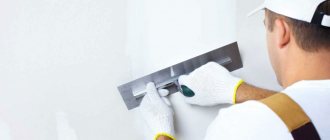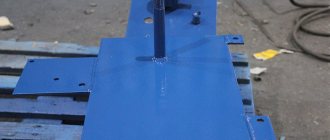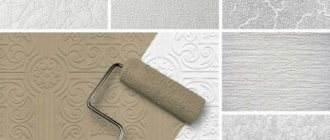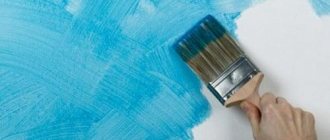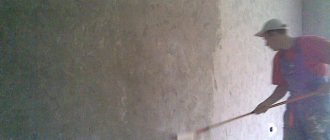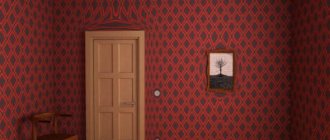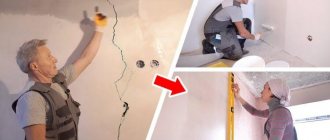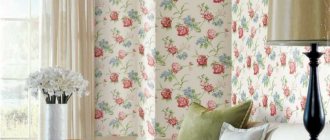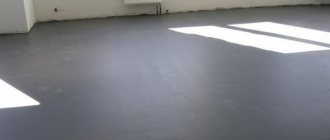Paint on the walls has long competed with traditional wallpaper and partially displaced it from our interiors. But high-quality painting requires filigree surface preparation, which significantly affects the cost of finishing. To save money, paintable wallpaper is used. They smooth out defects and visually level the surface of the wall, so careful preparation and sanding are not required. As a result, the cost of work is significantly reduced.
This finishing option has one more advantage - the presence of texture. Painting walls is a very delicate matter. Only the best craftsmen can do this job perfectly. If the surface is smooth, any flaws, smudges and unevenness will immediately catch the eye. On a textured surface, minor imperfections are almost invisible. Therefore, even a non-professional can successfully paint wallpaper.
So, wallpaper for painting is preferable if: a). there is a need to save; b). painting will be done by a person without much experience.
But this does not mean that painting wallpaper is easy. There are some nuances here. Let's look at frequently asked questions related to this type of work.
What wallpaper should I use for painting?
It is recommended to paint only those wallpapers that are labeled as a material suitable for painting. You can paint not only white or transparent wallpaper, but also colored ones.
There are different paintable wallpapers on sale: paper, fiberglass, non-woven. When it comes to a dry room, experts unanimously recommend giving preference to non-woven fabrics .
If the surface texture is undesirable, you can purchase so-called painting (repair) non-woven fabric. The optimal density of repair non-woven fabric for painting is 130 g/m2. But if the rough surface does not have cracks or obvious defects, a slightly less dense material will do.
Non-woven wallpaper is very easy to paste and perfectly hides various imperfections. There is no need to putty the already pasted wallpaper. You can paint them several times. glass wallpaper is more suitable for wet rooms - they tolerate such an environment better.
Which primer to choose
Construction stores sell different primer mixtures. They are chosen based on the type of wallpaper and paint composition. According to general rules:
- glass wallpaper can be treated with any primer, depending on the finish coating - for latex paint - latex, for acrylic paint - acrylic primer;
- in rooms with high humidity, a latex primer is used;
- Water-based paint requires a water-repellent treatment.
Wanting to save on materials, many continue to prepare walls for painting with old, “proven” means - homemade primer based on PVA or wallpaper glue. Such a mixture is conventionally called a primer: it does not impart the desired properties to the surface. Here, savings can backfire, and the wallpaper will no longer have to be repainted, but re-glued.
Do I need to prime wallpaper before painting?
Some say it is necessary, while others say it is not. In general, this is not necessary. But it doesn’t hurt to prime wallpaper with an absorbent surface (pure non-woven or fiberglass). Firstly, it will slightly reduce paint consumption. Secondly, the paint will apply a little better, more evenly.
If you plan to paint wallpaper with a non-woven base, but with a vinyl coating, there is no point in priming.
You can do without a primer. In this case, for the first layer the paint must be thoroughly diluted with water (up to 15% of water from the volume of paint).
Why apply primer to wallpaper?
The soil on the wallpaper performs several functions:
- improves adhesion of the base and topcoat;
- protects wallpaper;
- increases the wear resistance of the finish;
- reduces paint consumption;
- improves the quality of coloring.
The paint applies evenly to the prepared walls; without a primer, there is a risk of stains and stains. This is especially true for wallpaper that is not intended for painting.
When using water-based and water-dispersion dyes, the primer imparts water-repellent properties to the surface. Untreated wallpaper can simply become wet from the paint and slide off the wall due to its own gravity.
How can someone without experience paint wallpaper well?
Be sure to practice first. You can paste the wallpaper onto a large piece of plywood or drywall and do a test paint job. Be sure to wait until it dries completely to evaluate the result. You can also train directly on the wall - in an area that will subsequently be hidden from view (for example, behind a large closet).
Test colors help determine both the shade and the optimal consistency of the paint. If it lays down hard and rolls out poorly, you should dilute it a little more with water.
What wallpaper materials are intended for painting?
Using paintable wallpaper in the interior, on the one hand, is very beneficial. If desired, you can always carry out cosmetic repairs by refreshing or completely replacing the color. And you won’t need to re-wallpaper the walls. It is very practical and always original.
Typically, wallpaper intended for painting is white and has some textural feature. They come in different types:
The type of base affects the durability of the finish, decorative qualities and the cost of repairs. First you need to install the wallpaper materials, and this is a rather important stage of work. It is necessary to properly prepare the walls for pasting:
- level;
- prime;
- plaster;
- polish;
- clean from dust and dirt;
- prime again.
Only then is the installation of wallpaper materials carried out. For example, glass wallpaper is distinguished by its hypoallergenic properties. They are antistatic. And the natural raw materials used in their production make glass wallpaper non-toxic and environmentally friendly.
True, the finishing fabric is heavier than ordinary paper wallpaper, so stronger glue and, of course, a special primer are used. For heavy wallpaper, latex or acrylic primer mixtures with high adhesion are intended.
By the way, glass wallpaper does not require applying glue to the canvas, but only to the surface being treated. During work, you must take precautions - wear gloves and long sleeves.
Fiberglass wallpaper is a canvas made of small glass threads, particles of which, if they get on an open area of the skin, can cause irritation.
Which roller should I use for painting wallpaper?
It is recommended to paint with a velor or fur roller with short or medium pile. The deeper the wallpaper relief, the longer the roller pile.
The foam roller is not suitable.
New rollers often lose lint during the painting process. They stick to the paint and remain on the wall. To avoid this, it is recommended to carefully roll the new roller along the adhesive side of the tape. Poorly adherent lint will remain on the adhesive tape.
What wallpaper materials are intended for painting?
Using paintable wallpaper in the interior, on the one hand, is very beneficial. If desired, you can always carry out cosmetic repairs by refreshing or completely replacing the color. And you won’t need to re-wallpaper the walls. It is very practical and always original.
Typically, wallpaper intended for painting is white and has some textural feature. They come in different types:
The type of base affects the durability of the finish, decorative qualities and the cost of repairs. First you need to install the wallpaper materials, and this is a rather important stage of work. It is necessary to properly prepare the walls for pasting:
- level;
- prime;
- plaster;
- polish;
- clean from dust and dirt;
- prime again.
Only then is the installation of wallpaper materials carried out. For example, glass wallpaper is distinguished by its hypoallergenic properties. They are antistatic. And the natural raw materials used in their production make glass wallpaper non-toxic and environmentally friendly.
True, the finishing fabric is heavier than ordinary paper wallpaper, so stronger glue and, of course, a special primer are used. For heavy wallpaper, latex or acrylic primer mixtures with high adhesion are intended.
By the way, glass wallpaper does not require applying glue to the canvas, but only to the surface being treated. During work, you must take precautions - wear gloves and long sleeves.
Fiberglass wallpaper is a canvas made of small glass threads, particles of which, if they get on an open area of the skin, can cause irritation.
How to paint wallpaper?
Water-dispersed paint suitable for wallpaper should be diluted with water by 5-15%. In general, the thinner the paint, the easier it is to apply.
First you need to work with a brush. Go through the entire perimeter of the wall: corners, under the ceiling and near the floor. Then take a roller and quickly, without stopping or smoking breaks, paint the entire wall from corner to corner.
The roller should always be well moistened with paint. No need to squeeze it out. The roller does not rub the wall; it is rolled with light and quick movements.
The paint can be applied in a zigzag (w-shape) motion or in vertical stripes. In any case, the border between segments (squares, stripes) must be rolled up immediately. In general, you should paint very quickly. This is important, because all transitions must be rolled up before the paint begins to dry.
Wallpaper coloring technology
Before you start painting, you need to decide what paint to paint the wallpaper and stock up on the necessary tools. For this you will need:
One of the most important painting tools needed for painting large surfaces is a roller. The quality of painting will depend on it. The best option would be a fur coat with long pile. This is especially true for embossed wallpaper. Foam rollers are not suitable because air bubbles will likely appear on the surface during painting. Velor - absorb little paint; they are used if it is necessary to paint only the top layer of the relief pattern on the wallpaper.
To paint corners efficiently, use narrow rollers or brushes.
Brushes are an indispensable tool for painting corners
Before starting work, floors, window sills and radiators must be covered with plastic film or newspapers to prevent paint from getting on them. Skirting boards, sockets and switches can be removed or sealed with wide masking tape.
To obtain a high-quality result, it is very important to adhere to the manufacturer’s recommendations, which can be found on any can of coloring composition. It is possible that before using the paint, it will need to be diluted with water and everything must be mixed thoroughly until a homogeneous consistency is obtained.
First, use a flat brush to paint the corners, then the stripes along the floor and ceiling. It is necessary to paint the wall in parts, and not along the entire perimeter of the wall at once. In order to avoid spots and streaks, the work must be done quickly so that the previously applied paint does not have time to dry completely.
How not to paint over the texture of wallpaper?
If the wallpaper has a texture, it is advisable to preserve it. After all, it, among other things, will allow you to hide both the unevenness of the rough surface and the imperfections of the painting. But how can you not paint over the fine texture of the wallpaper?
Latex water-dispersion paints adhere well to textured surfaces. You need to dilute the paint with water, because the thinner it is, the thinner the layer. You will have to apply at least 2 layers. The first one is a thinner paint, the second one is a little thicker. It is very important to carefully roll out the paint so that it lays on the wallpaper in as thin a layer as possible.
Why prime the wall after removing old wallpaper?
When performing finishing work on their own, many apartment owners cannot decide on the answer to the question: why prime the walls before wallpapering, when the surface, as a result of dismantling the old material, looks quite smooth and neat?
The answer depends on the method of dismantling the coating and the quality of the actions performed. If the coating was removed without using a spatula, using special solutions, and the surface of the wall was already puttied and treated with primer, applying a new layer of impregnation is not necessary. All you need to do is remove the screws or nails, mask the holes with putty and prime these areas, and then apply a new coating.
If tools were used during dismantling and the base was damaged, additional leveling with putty solutions and re-treatment with a primer solution will be required. Otherwise, reliable adhesion of the adhesive to the base surface will not be ensured and the service life of the wallpaper will be greatly reduced.
What paint should I use for wallpaper?
Of course, water-dispersed. You can safely use any water-based paint that is declared as wallpaper paint.
In addition, any latex and acrylate paints will do, even if they are not indicated as recommended for wallpaper. Brand and price are more important here. It’s trite, but the more expensive the paint and varnish, the higher its quality.
Author: Sergey Rogov
Methods for applying primers
Primers are applied in such a way that it dries in at least half an hour, and not instantly. The strength of holding glass wallpaper for painting in a vertical position depends on the degree of impregnation of the wall surface with the primer composition.
For large volumes of surfaces to be pasted, it is more convenient to use a sprayer. Using a sprayer will allow you to rationally use expensive material without unnecessary cost overruns. Spraying is performed in several passes without waiting for the layer to completely dry. The layer is applied evenly and without smudges.
You can also apply the primer using a roller or a wide brush. It is advisable to perform such work in small areas. It is necessary to adhere to safety precautions in terms of skin and eye protection. Wear long sleeves, gloves, safety glasses, and a respirator. Contact of primers on exposed areas of the body may cause skin irritation.
Using primers or special glue for heavy wallpaper as a primer will give a good result in that you don’t have to re-glue individual sheets. The primer allows you to achieve the required adhesion between materials and your repair (pasted wallpaper) will last for many years.
